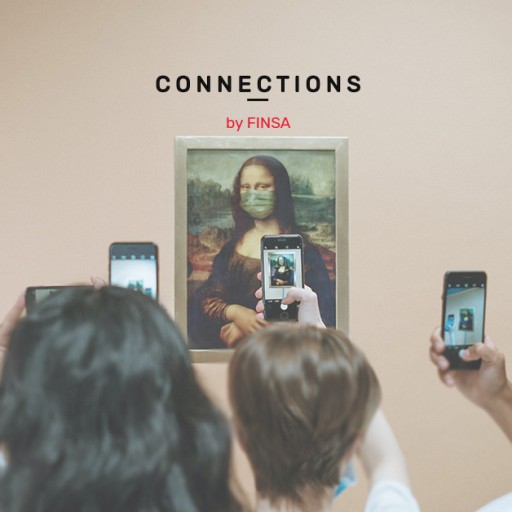Carolina Calzada is a colour consultant that began working in the field after starting out in marketing. Her company Calzada Fox works with several industries to help them take advantage of the use of colour by adapting it to their goals, be it product development, creating a brand, entering new market, or something else entirely. We spoke to her about the power of colour.
How can colour make our lives better?
In many ways. At the moment, Calzada Fox is focused on studying how colour can improve city life by, for example, reducing global warming or in other areas of sustainability. There is also wellbeing and social integration: from office design to homes or public spaces, everyone can benefit from improved use of colour. It can even improve the inclusivity of spaces for people with visual impairment, such as those that have trouble seeing certain colours. If you are genetically predisposed to a particular mental illness, colour can even stop it from intensifying. Right now, we are working on a project in Mexico where we are painting the waiting area of a hospital for children with mental illnesses in order to reduce anxiety and agitation among their family members.
https://www.instagram.com/p/B9uuCazhyFT/?utm_source=ig_web_copy_link
What does colour have to do with sustainability and reducing global warming?
It has one of the biggest impacts on global warming. A government project in the city of New York was able to reduce the temperature of the city by two to three degrees by painting rooftops white instead of the usual black. The number of suicides also reduced. So, if we were to paint everything white, we would reduce the temperature of cities. But would we really like to live in complete white spaces?
This story shows how the colour of the building really does have an impact. Calzada Fox has also created the Colour Manifesto, which helps architects and government bodies that are involved in city planning see the value in colour beyond just the aesthetics. Last year we started talking with an internationally known architecture studio, explaining the implications that colour has so that they could choose a colour for a project from the very beginning, taking into account the benefits for sustainability and space creation in cities. We talked about how painting the façade of a building using a colour that is then reflected in the façade of the building opposite seems like an invasion of interior space, or how using tinted windows with different tonalities for the balconies can cause the temperature to rise inside the building.
So is there a problem in terms of a lack of education and knowledge about colour in architecture?
Yes, because at university they learn how to use colour artistically rather than from a commercial point of view, and the way they work means they always use the same palette that works for them. Sometimes they want to do things differently, but they can’t because of the intervention of urban planners from the government, who end up choosing the colour [for a project]. The belief that white paint is the cheapest option also has an impact. From a sustainability point of view, it’s not a bad idea, but you have to think about how it can be combined with other colours. We do a lot of workshops and webinars to increase their knowledge about combining colours. Humans are more attracted to colours that work in harmony and sometimes architects feel that they don’t have enough knowledge to create this harmony. That’s why they work with companies like us.
https://www.instagram.com/p/B9_7B9zDOOp/?utm_source=ig_web_copy_link
Is it possible to design something without making decisions about colour?
If you’re designing a product, your objective is to arouse interest in consumers for whom colour is key, but it all depends on your creative process. Architecture studios are used to deciding on materials at the beginning and they use this as an excuse to say that this limits the colour palette. But that’s not true, because now materials are available in a range of colours. Decorators create colour palettes on their moodboards, which is why they place more importance on colour combinations and creating harmony.
How is a colour trend created?
Trend creation is a fascinating job because it gives you the chance to research and talk to people that think in a very different way and see the world from another point of view. One of the methods that works best is organising panels to which we invite experts from different fields so that they can talk to us about the future. In interior decorating, trends are created every two years, and in the automotive industry they are created between five and ten years ahead. They are research projects in which we look at other fields like the economy, the environment, and the arts. Trends serve to help us identify changes in the behaviour of consumers: what they are going to like, what kind of world are they going to be living in etc.
Do you think that this crisis is going to affect colour trends?
Of course, but some radical changes had already been foreseen, though their source had not been identified. We were already preparing for a crisis, but it was thought that it would be linked to environmental disasters, because trends often start with a problem. Trends are evolving because consumerism is changing. Less is more and we want to have less things and over time we will start to develop macrotrends.
Nevertheless, there is always the calm after the storm, and we hope that after this crisis, new creative movements and opportunities for transformation will emerge. That’s why it’s very important that the design community remains in contact with each other and one way to do this is by talking about trends and colours.
https://www.instagram.com/p/B9_7Mrgj4EM/?utm_source=ig_web_copy_link
Can colours help us in times of crisis like what we are experiencing now?
The psychology of colour applied to improving wellbeing will be a huge help after this crisis. We will be facing mental health problems because of the losses that we are dealing with, which is why we will need to focus on forgetting and looking forward. Governments will need to invest in wellbeing programs and an easy way to do this is through the use of colour.
A few days ago, we posted three colours on Instagram that can help us due to their characteristics:
- Orange with red undertones: it’s a colour that transmits energy, humour, and strength, and it can be used in the online meetings that we are all having or to help the image of your brand online
- Pale yellow (vanilla): it reminds us of the technological future, and it’s a friendly colour because of its cool tones.
- Dark green turquoise: blues and greens transmit a sense of harmony and help us relax in moments of tension, making us feel more positive.
The impact of colour on our emotions is often talked about, but what does colour have to do with economy or politics?
Colour is influenced by political or economic issues when you’re designing colour trends because they reflect the social state of affairs. For example, this new social distancing might mean that people want warmer homes, with spaces that make us feel better. In interior decorating, colour is used in a functional way and focuses on how it can benefit the user of the space and help that space fulfil its function.
https://www.instagram.com/p/B9_7G_aDyYj/?utm_source=ig_web_copy_link
Given the current confinement that the Western world is living in, do you think we will be more aware of the importance of colour in interior spaces?
I hope so. Sometimes we choose colours based on our tastes and not what works in a particular space. Most of the time it’s because we don’t know how to make a colour palette or because we don’t understand the characteristics of each colour well enough. That’s why Calzada Fox wants to democratize colour and make it more accessible to designers and users via online courses.
What do you work on at Calzada Fox?
I had already worked with colourist Justine Fox before and we thought about starting a company where we could work with people that we like doing projects that we like. So our team is made up of collaborators that each bring something different to the table and we continue to learn from them every day. Our services are very focused on education in order to help professionals consider colour from the very beginning of any project. That’s why we offer everything from educational programs to consultancy. But we also continue to develop products with some of our clients and to create publications.
https://www.instagram.com/p/B21uXiDhLlf/?utm_source=ig_web_copy_link




